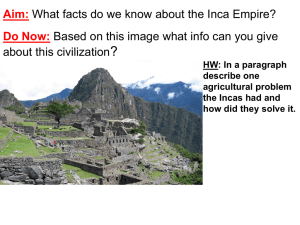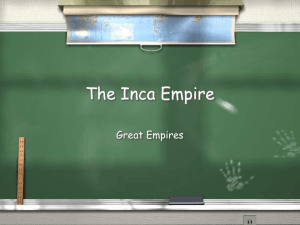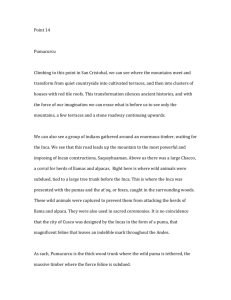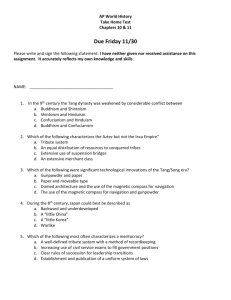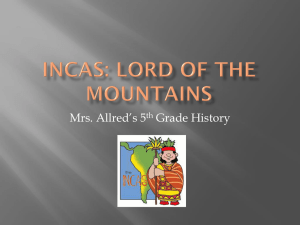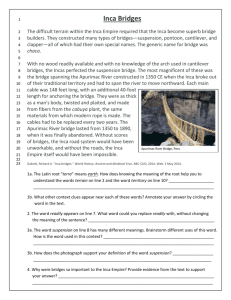Brochure
advertisement
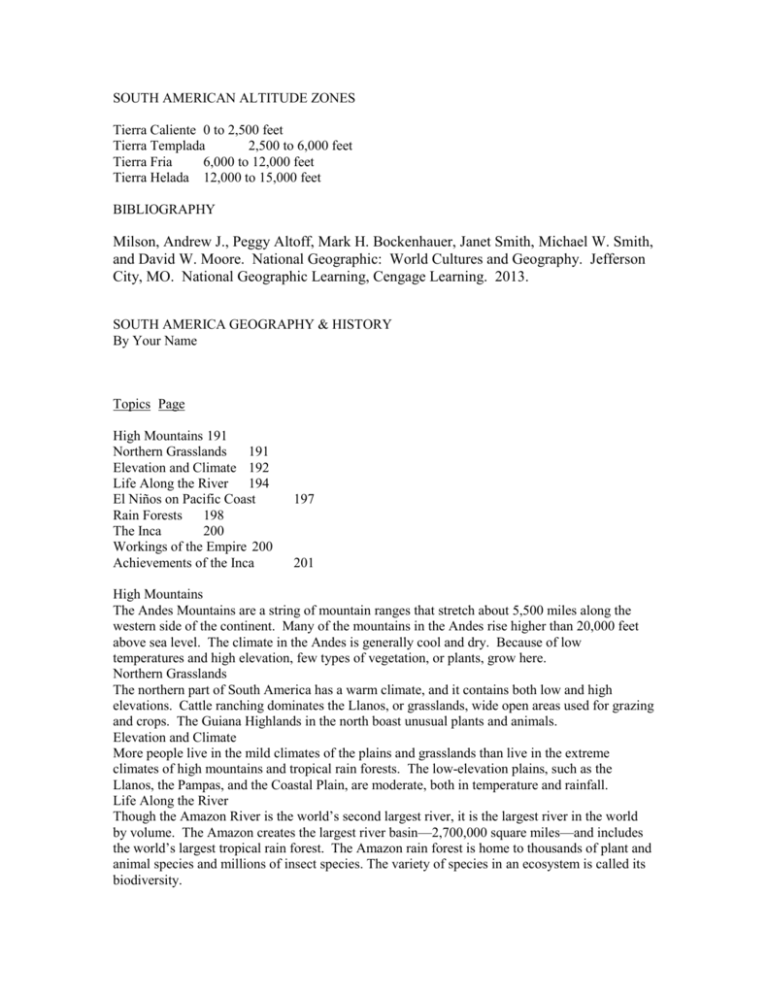
SOUTH AMERICAN ALTITUDE ZONES Tierra Caliente 0 to 2,500 feet Tierra Templada 2,500 to 6,000 feet Tierra Fria 6,000 to 12,000 feet Tierra Helada 12,000 to 15,000 feet BIBLIOGRAPHY Milson, Andrew J., Peggy Altoff, Mark H. Bockenhauer, Janet Smith, Michael W. Smith, and David W. Moore. National Geographic: World Cultures and Geography. Jefferson City, MO. National Geographic Learning, Cengage Learning. 2013. SOUTH AMERICA GEOGRAPHY & HISTORY By Your Name Topics Page High Mountains 191 Northern Grasslands 191 Elevation and Climate 192 Life Along the River 194 El Niños on Pacific Coast Rain Forests 198 The Inca 200 Workings of the Empire 200 Achievements of the Inca 197 201 High Mountains The Andes Mountains are a string of mountain ranges that stretch about 5,500 miles along the western side of the continent. Many of the mountains in the Andes rise higher than 20,000 feet above sea level. The climate in the Andes is generally cool and dry. Because of low temperatures and high elevation, few types of vegetation, or plants, grow here. Northern Grasslands The northern part of South America has a warm climate, and it contains both low and high elevations. Cattle ranching dominates the Llanos, or grasslands, wide open areas used for grazing and crops. The Guiana Highlands in the north boast unusual plants and animals. Elevation and Climate More people live in the mild climates of the plains and grasslands than live in the extreme climates of high mountains and tropical rain forests. The low-elevation plains, such as the Llanos, the Pampas, and the Coastal Plain, are moderate, both in temperature and rainfall. Life Along the River Though the Amazon River is the world’s second largest river, it is the largest river in the world by volume. The Amazon creates the largest river basin—2,700,000 square miles—and includes the world’s largest tropical rain forest. The Amazon rain forest is home to thousands of plant and animal species and millions of insect species. The variety of species in an ecosystem is called its biodiversity. El Niños on the Pacific Coast El Niños influence climate on the western coast of South America. An El Niño (ehl NEEN yoh) happens when the usual wind and ocean currents reverse. This reversal brings warm air currents and water currents that produce high rainfall in coastal areas. El Niños occur in Peru because of its location in the current system and on the Pacific coast. The Peru Current brings cold waters to the Pacific coast in the west. The Peru Current carries nutrient-rich waters from deep in the Pacific Ocean, so fish thrive off the coasts of Chile, Peru, and Ecuador. Brazil Current brings warm waters from the Atlantic. The plains of the Pampas benefit from the Brazil Current. Rain Forests Through a process called transpiration, plants and trees release water vapor into the air. As the water vapor rises, it cools, forming thick clouds that then produce rain. The warm air and moist soil support the growth of vegetation. The plants in the Amazon rain forest perform an important function. They absorb greenhouse gases from Earth’s atmosphere. A greenhouse gas is a gas that traps heat energy, warming the earth. Burning fossil fuels, such as coal and oil, produces greenhouse gases like carbon dioxide. The Inca The Inca rules a vast empire in a difficult, mountainous environment. The Inca Empire in South America stretched along the Pacific coast. Workings of the Empire The Inca built the capital of their empire in Cuzco, in what is now Peru. Inca government and society were highly organized. The emperor, called the Sapa Inca, was considered a descendant, or a relative of the sun god, Inti. Achievements of the Inca The Inca utilized, or made practical use of, their advanced engineering skills to adapt to the mountainous environment. For example, the Inca farmed on terraced fields, or flat fields cut into slopes or mountainsides. They also built irrigation canals to water their crops because the climate was arid. The Inca adapted to their mountainous surroundings in other ways. They built: Suspension bridges using vines and wood. System of roads that helped keep the empire unified. Built a complex city on a mountain, called Machu Picchu.

